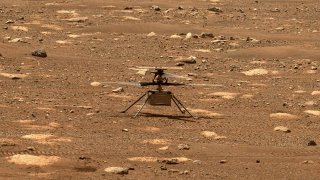
NASA’s Ingenuity helicopter on April 7, 2021 as it prepared to fly.
On its ambitious sixth flight, the Mars helicopter Ingenuity encountered an airborne navigation glitch that caused it to tilt back and forth while making unplanned velocity changes, but the small drone-like craft was still able to land safely, mission managers at Jet Propulsion Laboratory in Pasadena said today.
The sixth flight of the history-making helicopter — the first to perform controlled flight on another world — was planned as one of its most daring excursions to date. The helicopter was programmed to travel a total of more than 700 feet, demonstrating its aerial photography skills by snapping stereo images of terrain to its west while it flew, then touch down in a new landing field.
Near the end of the helicopter's initial 492-foot flight to the southwest, Ingenuity suddenly "began adjusting its velocity and tilting back and forth in an oscillating pattern," according to a flight recap from Havard Grip, the helicopter's chief pilot at JPL.
"This behavior persisted throughout the rest of the flight," Grip wrote. "Prior to landing safely, onboard sensors indicated the rotorcraft encountered roll and pitch excursions of more than 20 degrees, large control inputs, and spikes in power consumption."
Get DFW local news, weather forecasts and entertainment stories to your inbox. Sign up for NBC DFW newsletters.
In the end, Ingenuity was able to land safely, touching down within about 16 feet of its originally intended landing spot.
According to Grip, the glitch occurred roughly 54 seconds into the flight, when a constant stream of camera images — snapped at about 30 pictures per second and fed into the helicopter's navigation system — was interrupted.
The glitch caused only one image to be lost. And while that seems like a minor issue, it caused all subsequent images to have inaccurate timestamps, which are used by the helicopter's navigation system to determine its location, speed and positioning.
Grip said the helicopter was able to ultimately complete its flight thanks to a "stability margin" that was built into the rotorcraft to ensure it can "tolerate significant errors without becoming unstable, including errors in timing."
The helicopter is also designed to land on the Martian surface without
need of the navigation cameras, so the delayed imaging had no impact on its
ability to touch down safely.
"Looking at the bigger picture, Flight Six ended with Ingenuity safely on the ground because a number of subsystems — the rotor system, the actuators and the power system — responded to increased demands to keep the helicopter flying," Grip wrote.
"In a very real sense, Ingenuity muscled through the situation, and while the flight uncovered a timing vulnerability that will now have to be addressed, it also confirmed the robustness of the system in multiple ways."
Ingenuity was carried to the Red Planet attached to the belly of the Perseverance rover, which landed on Mars in February. The helicopter is strictly a demonstration project and carries no scientific equipment. JPL officials are continuing to test its capabilities to gauge the potential for such craft to be used in future missions, providing a way to explore more of the planet's surface than land-based rovers.